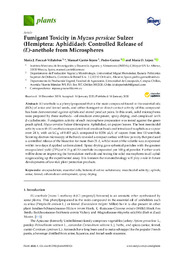Please use this identifier to cite or link to this item:
https://hdl.handle.net/11000/30866Full metadata record
| DC Field | Value | Language |
|---|---|---|
| dc.contributor.author | Pascual-Villalobos, Maria Jesus | - |
| dc.contributor.author | Cantó-Tejero, Manuel | - |
| dc.contributor.author | Guirao, Pedro | - |
| dc.contributor.author | López Belchí, Maria Dolores | - |
| dc.contributor.other | Departamentos de la UMH::Producción Vegetal y Microbiología | es_ES |
| dc.date.accessioned | 2024-01-31T10:57:27Z | - |
| dc.date.available | 2024-01-31T10:57:27Z | - |
| dc.date.created | 2020-01-18 | - |
| dc.identifier.citation | Plants 2020, 9(1), 124 | es_ES |
| dc.identifier.issn | 2223-7747 | - |
| dc.identifier.uri | https://hdl.handle.net/11000/30866 | - |
| dc.description.abstract | (E)-anethole is a phenylpropanoid that is the main compound found in the essential oils (EOs) of anise and fennel seeds, and either fumigant or direct contact activity of this compound has been demonstrated against aphids and stored product pests. In this work, solid microspheres were prepared by three methods—oil emulsion entrapment, spray-drying, and complexed with β-cyclodextrin. Fumigation activity of each microsphere preparation was tested against the green peach aphid, Myzus persicae Sulzer (Hemiptera: Aphididae), on pepper leaves. The best insecticidal activity was with (E)-anethole encapsulated in oil emulsion beads and introduced to aphids as a vapour over 24 h, with an LC50 of 0.415 μL/L compared to 0.336 μL/L of vapors from free (E)-anethole. Scanning electron microscopy of the beads revealed a compact surface with low porosity that produced a controlled release of the bioactive for more than 21 d, whilst most of the volatile was evaporated within two days if applied unformulated. Spray drying gave spherical particles with the greatest encapsulated yield (73%) of 6.15 g of (E)-anethole incorporated per 100 g of powder. Further work will be done on improving the formulation methods and testing the solid microspheres in all aphid stages scaling up the experimental assay. It is foreseen that nanotechnology will play a role in future developments of low risk plant protection products | es_ES |
| dc.format | application/pdf | es_ES |
| dc.format.extent | 11 | es_ES |
| dc.language.iso | eng | es_ES |
| dc.publisher | MDPI | es_ES |
| dc.rights | info:eu-repo/semantics/openAccess | es_ES |
| dc.rights | Attribution-NonCommercial-NoDerivatives 4.0 Internacional | * |
| dc.rights.uri | http://creativecommons.org/licenses/by-nc-nd/4.0/ | * |
| dc.subject | Encapsulation | es_ES |
| dc.subject | Essential oils | es_ES |
| dc.subject | Botanical active substances | es_ES |
| dc.subject | Insecticidal activity | es_ES |
| dc.subject | Aphids | es_ES |
| dc.subject | Anise | es_ES |
| dc.subject | Fennel | es_ES |
| dc.subject | Oil emulsion entrapment | es_ES |
| dc.subject | Spray drying | es_ES |
| dc.title | Fumigant Toxicity in Myzus persicae Sulzer (Hemiptera: Aphididae): Controlled Release of (E)-anethole from Microspheres | es_ES |
| dc.type | info:eu-repo/semantics/article | es_ES |
| dc.relation.publisherversion | https://doi.org/10.3390/plants9010124 | es_ES |

View/Open:
Aportacion 3.pdf
2,56 MB
Adobe PDF
Share:
.png)
